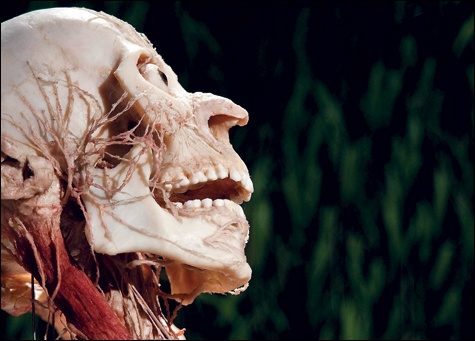Body Worlds 2 at Museum of Science
Reflections on an Extraordinary Exhibition of the Human Body
By: Astrid Hiemer - Jan 26, 2007
The anatomical exhibition of real human bodies closed in early January without media controversy and to record breaking attendance at the
I came with great expectations into the special halls, where hundreds of visitors were milling around the exhibition cases or body stands. The mood was hushed or people were talking intently with each other, moving respectfully from area to area. I saw a couple of ten year old boys resting casually on a low pedestal in front of one body-exhibition. Every item in this exhibition came from donations to the Institute for Plastination in
How gruesome, one might think, but in fact, as I reflect on the placement of the installations, the visitor is slowly prepared by first viewing a couple of large cases with body parts as one might have seen in the past and a regular skeleton, which every student has probably been introduced to in a biology or anatomy class. These Plastinates are often presented in poses with "props:" a skier, with skies in flight; a ballet dancer, on toes and ballet shoes; a baseball player, holding a bat, in a correctly leaning position. These Plastinates were mostly seen at the layer of the muscles and gave the appearance of a "normal" body. A more emotionally challenging Plastinate was titled "The Drawer Man, 1999," where different parts and organs were cut out resembling drawers and pulled away from the body, to see the size and position of each part and organ; or the ten foot tall "out of body experience," the "Exploded Body, 2005," where every part of the body was hung from fish-wire. I moved on fairly quickly.
However, I felt very thankful to the pregnant woman for donating her body and fetus. She knew that she would not carry her baby to full term and a black lung was exposed on her back. The Plastinate was exhibited frontally with the skin intact, but the stomach cut open to expose the five months old fetus in position. As I am writing this, I still feel for this mother, who would not live to deliver her baby. The special section on Embryonic and Fetal Development showed embryos in glasses at day four to eighteen, from a small dot to the beginning of body formation, and exhibited fetuses of various stages and diseases.
Black lungs were prominently exhibited in a large glass case. They were lungs of smokers and of miners and were installed next to healthy lungs, which was quite shocking to see. One could also view normal and cirrhosis livers of people, who died of alcoholism, which was equally shocking. The actor Yul Brunner made a TV advertisement in 1985, at age 63, before he died of lung cancer, which was presented here, urging every smoker to stop smoking at once and one could discard the current cigarette pack in a large glass box. I watched a daughter, who was questioned by her mother, whether she indeed had thrown her cigarettes into the box already filled with many brands and chewing tobacco. The younger woman confirmed and I had observed an intimate moment.
Many other glass-vitrines showed specimens of open brains and in skulls, the respiratory system, the cardiovascular system, the digestive system and the abdominal organs; the kidneys and urinary tract, the reproductive organs, and even transparent body slices. "Obesity Revealed, 2005," was the most shocking one, because fat forms layers around the inside of the body parts as well as under the skin.
A few animals were also on exhibit: A couple of horses, a camel and baby camel. Visitors marveled at the size of the mother camel with visible digestive track and stomachs. The camels were set in an oasis like environment, so that they appeared very "normal." How could this huge Plastinate be moved and installed?
And who continues to supply the bodies? Donation applications were available and an oversized application form of a male, living in
Close to the exit of Body Worlds 2 one encountered the most amazing of all Plastinates, "Eloquence on Ice, 2005," a couple of ice skaters, where the male was positioned behind the female skater and held the counter balance to her performing a pirouette close to the ground. I overheard a young visitor exclaiming: "This is it? I want to keep going!"
The Plastination Processes: Fluids and soluble fats in their tissues have been replaced initially with ice-cold acetone and then with plastic in a vacuum. The reactive plastics are: silicone rubber or epoxy resin remain dry, odorless, and accurate in detail down to microscopic level and can be pliable, rigid or even transparent. (As described in the catalogue "Body Worlds")
"Body Worlds" ( "Koerper Welten") may be seen during 2007 at the Museum of Nature and Science, Dallas, Texas, and Houston Museum of Natural Science, in Texas as well as at MSI Chicago, Illinois.
This writer highly recommends visiting the exhibition!


